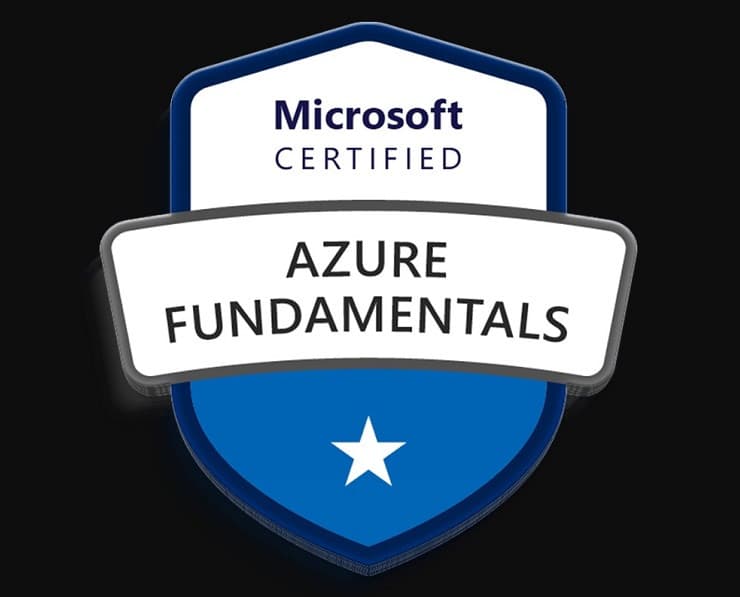Student Feedback
70-742: Identity with Windows Server 2016 Certification Video Training Course Outline
Installing and Configuring Domai...
Managing AD DS Objects
Securing Active Directory Domain...
Installing and Configuring Domain Controllers
70-742: Identity with Windows Server 2016 Certification Video Training Course Info
Microsoft 70-742 Exam Guide: Identity and Access Solutions in Windows Server 2016
Comprehensive Online Training on Windows Server 2016 Identity
What you will learn from this course
• Deploy and configure Active Directory Domain Services (AD DS) in Windows Server 2016
• Operate and maintain AD DS to ensure smooth network operations
• Create, manage, and troubleshoot Group Policy to enforce organizational policies
• Implement and manage Active Directory Certificate Services (AD CS) for secure authentication
• Design and deploy identity federation and access solutions using Windows Server 2016
• Configure and troubleshoot Active Directory Federation Services (AD FS)
• Manage users, groups, and organizational units efficiently
• Understand security and access control in identity services
• Apply best practices for monitoring and maintaining identity infrastructure
• Prepare for Microsoft 70-742 exam and MCSA: Windows Server 2016 certification
Learning Objectives
The main goal of this course is to equip IT professionals with in-depth knowledge and practical skills for managing identity and access solutions in Windows Server 2016. Upon completion of this course, learners will be able to:
Deploy and configure Active Directory Domain Services in complex environments, including multiple domains and forests.
Manage and maintain AD DS to ensure optimal performance, reliability, and security.
Create and configure Group Policy Objects to manage user and computer settings efficiently.
Implement Active Directory Certificate Services to provide secure authentication and encryption.
Design and implement identity federation solutions using Active Directory Federation Services for seamless access across organizational boundaries.
Monitor and troubleshoot identity services to resolve issues quickly and minimize downtime.
Understand security best practices for identity services, including permissions, auditing, and access control.
Integrate identity services with other Microsoft technologies to enhance overall IT infrastructure.
Prepare effectively for Microsoft 70-742 exam by aligning practical skills with exam objectives.
Target Audience
This course is intended for IT professionals who want to specialize in identity and access management using Windows Server 2016. The primary audience includes:
System administrators seeking to enhance their knowledge of Active Directory and related identity technologies.
Infrastructure administrators with prior experience in AD DS who wish to expand their expertise to advanced identity solutions.
IT professionals aiming to implement and manage secure identity services in enterprise environments.
Candidates preparing for the Microsoft 70-742 exam and MCSA: Windows Server 2016 certification.
Network engineers and IT consultants responsible for deploying and maintaining Windows Server 2016 identity infrastructure.
Requirements
This course assumes that learners have a foundational understanding of Windows Server environments and basic Active Directory concepts. Practical experience in a Microsoft network environment is highly recommended for optimal understanding.
Prerequisites
Before enrolling in this course, students should have:
Basic knowledge of Active Directory concepts, including domains, trees, forests, and organizational units.
Understanding of Domain Name System (DNS) and its integration with Active Directory.
Familiarity with Windows Server 2012 or 2016 administration.
Hands-on experience in managing users, groups, and permissions in a Microsoft environment.
Basic knowledge of network protocols and Windows authentication mechanisms.
Prior exposure to Group Policy concepts and their application in a corporate environment.
Overview
Identity management is the cornerstone of secure IT environments. In Windows Server 2016, Microsoft provides robust services for managing users, devices, and access permissions efficiently. Active Directory Domain Services (AD DS) is the core component, allowing administrators to organize and manage resources across the network. AD DS is responsible for storing directory information, authenticating users, and enforcing security policies.
Group Policy is another key component that enables administrators to apply consistent configurations across all computers and users in a domain. It allows for centralized management, making it easier to enforce security settings, software installation policies, and user restrictions. Proper configuration and troubleshooting of Group Policy are essential skills for any IT professional working with Windows Server 2016.
Active Directory Certificate Services (AD CS) extends security by providing digital certificates for authentication, encryption, and secure communications. These certificates are used in scenarios such as VPN access, secure email, and network authentication. Learning to deploy and manage AD CS ensures that IT environments remain secure and compliant with organizational policies.
Identity federation solutions, implemented through Active Directory Federation Services (AD FS), allow organizations to provide single sign-on access to applications across multiple domains or even different organizations. This is particularly important for enterprises that rely on cloud-based services or need to provide access to external partners securely. Configuring and managing AD FS involves understanding claims-based authentication, trust relationships, and federation protocols.
Deploying and Managing Active Directory Domain Services
Deploying AD DS begins with planning the forest and domain structure. Proper planning ensures that the environment scales efficiently and maintains security and performance standards. Administrators must decide on domain naming conventions, organizational unit structures, and delegation of administrative permissions.
Once deployed, maintaining AD DS involves monitoring replication between domain controllers, ensuring backups, and applying updates and patches to maintain security and functionality. IT professionals must also manage user accounts, computer accounts, and group memberships to ensure that resources are accessible to authorized users while maintaining security.
Group Policy Management
Group Policy enables centralized management of user and computer settings. Administrators can create Group Policy Objects (GPOs) linked to specific organizational units or domains to enforce policies consistently. Common tasks include configuring password policies, software deployment, desktop restrictions, and security settings. Troubleshooting GPOs involves understanding inheritance, scope, and precedence of policies applied across the network.
Active Directory Certificate Services
AD CS allows administrators to issue and manage digital certificates that secure network communications. Certificates can be used for SSL/TLS encryption, secure email, smart card authentication, and VPN connections. Deploying AD CS involves configuring certificate authorities, managing certificate templates, and ensuring proper certificate enrollment and revocation processes.
Identity Federation and Access Management
AD FS enables secure access to applications across different domains or organizations. IT professionals need to understand claims-based authentication, federation trusts, and security tokens. Implementing AD FS ensures seamless single sign-on experiences while maintaining control over authentication and authorization processes.
Monitoring and Troubleshooting Identity Services
Monitoring Active Directory and related identity services is essential to detect issues before they impact users. Administrators use tools such as Event Viewer, performance monitoring, and AD-specific diagnostic commands to track system health and troubleshoot problems. Common issues include replication errors, authentication failures, and misconfigured policies. Developing troubleshooting skills ensures high availability and reliability of identity services.
Exam Preparation and Certification
This course aligns with Microsoft 70-742 exam objectives, preparing learners to achieve the MCSA: Windows Server 2016 certification. Practical experience combined with course knowledge helps candidates confidently manage identity services and successfully pass the certification exam. The course emphasizes hands-on labs, real-world scenarios, and practical exercises to reinforce learning.
Course Modules / Sections
The 70-742: Identity in Windows Server 2016 course is organized into a series of structured modules that guide learners through both foundational and advanced topics. Each module focuses on practical skills and conceptual understanding to ensure learners gain mastery in managing identity services in Windows Server 2016.
The first module introduces Active Directory Domain Services, providing a comprehensive overview of its architecture, components, and the role it plays in enterprise networks. Learners explore domain controllers, forests, domains, organizational units, and user and group management. Practical demonstrations are used to illustrate deployment scenarios, best practices, and common troubleshooting steps.
The second module focuses on Group Policy management, beginning with the fundamentals of Group Policy Objects (GPOs) and progressing to advanced configuration techniques. Learners will understand the process of creating, linking, and enforcing GPOs across multiple domains and organizational units. This module also addresses Group Policy inheritance, security filtering, and troubleshooting common policy conflicts.
The third module covers Active Directory Certificate Services, emphasizing the deployment of certification authorities, certificate templates, and certificate lifecycle management. Learners will gain hands-on experience in configuring certificate authorities, managing certificate enrollment, and implementing secure communication through certificate-based authentication.
The fourth module is dedicated to Active Directory Federation Services (AD FS) and identity federation solutions. Topics include configuring single sign-on access, managing claims-based authentication, and establishing trust relationships between organizations. Practical labs allow learners to implement federation services in controlled environments to understand security implications and operational requirements.
The fifth module focuses on monitoring, auditing, and troubleshooting identity services. Learners will explore tools such as Event Viewer, Performance Monitor, and PowerShell cmdlets to monitor system health, detect errors, and resolve replication or authentication issues. The module also covers auditing best practices and security event management.
The final module emphasizes exam preparation and real-world application of the knowledge gained throughout the course. This includes case studies, scenario-based exercises, and guided labs that simulate common challenges faced by IT professionals managing identity services. This module ensures that learners are fully prepared for both certification exams and practical deployment scenarios in enterprise environments.
Key Topics Covered
The 70-742 course covers a wide range of topics essential for IT professionals managing Windows Server 2016 identity services. Key topics include the deployment and configuration of Active Directory Domain Services. This includes understanding the architecture of AD DS, creating and managing domains, configuring domain controllers, and organizing resources using organizational units. Learners also focus on the creation and management of user and group accounts, permissions, and role delegation.
Group Policy management is another core topic. Learners explore the creation, linking, and configuration of GPOs to enforce security and operational policies. Topics also include troubleshooting policy conflicts, managing software deployment through Group Policy, and implementing security configurations to ensure organizational compliance. Advanced GPO features such as security filtering, WMI filtering, and loopback processing are covered in depth.
Active Directory Certificate Services is an important area of study. Learners will understand how to deploy certification authorities, manage certificate templates, and implement secure authentication mechanisms. Topics also cover certificate enrollment processes, revocation, and renewal, as well as integrating certificates into various services and applications to secure communication and user authentication.
Identity federation using AD FS is covered extensively. Learners explore claims-based authentication, federation trusts, and single sign-on solutions. The course provides hands-on labs to configure AD FS, integrate with cloud-based services, and establish secure access for external partners. Troubleshooting federation services and maintaining security across trust boundaries is emphasized.
Monitoring and troubleshooting are critical topics in this course. Learners are trained to use diagnostic tools, track replication, monitor authentication processes, and resolve service outages. Security auditing, event management, and performance optimization strategies are discussed to maintain high availability and reliability of identity services.
The course also includes preparation for Microsoft 70-742 exam objectives. Key topics include aligning practical knowledge with exam goals, understanding exam-style scenarios, and developing strategies to approach technical questions effectively. Real-world examples and case studies ensure that learners can apply theoretical concepts to practical challenges in enterprise environments.
Teaching Methodology
The teaching methodology of the 70-742 course is designed to combine conceptual learning with practical hands-on experience. Each topic is introduced through clear explanations and demonstrations, followed by guided lab exercises that allow learners to implement the concepts in controlled environments.
Interactive lectures are used to provide in-depth understanding of identity services, including Active Directory Domain Services, Group Policy, AD CS, and AD FS. Learners are encouraged to explore system configurations, experiment with policies, and troubleshoot issues in a safe and structured environment.
Hands-on labs form a critical part of the learning methodology. Labs are designed to simulate real-world enterprise environments, enabling learners to deploy domain controllers, configure GPOs, implement certificate services, and set up federation solutions. These exercises build confidence in applying knowledge practically and ensure learners develop problem-solving skills applicable in their workplaces.
Scenario-based learning is also emphasized. Learners work on case studies representing common challenges faced in identity management. These scenarios cover topics such as replication failures, authentication issues, certificate deployment challenges, and policy conflicts. By analyzing and resolving these scenarios, learners gain experience in applying theoretical knowledge to real-life problems.
Assessment and feedback are integrated into the teaching methodology. Learners receive guidance and feedback on lab exercises, scenario-based projects, and practical tasks. This ensures continuous improvement and mastery of skills. The course encourages collaborative learning through discussions, knowledge sharing, and peer review of solutions.
Supplementary materials, including reference guides, practical exercises, and study aids, are provided to reinforce learning. Learners are encouraged to use these materials to explore advanced topics, deepen their understanding, and prepare for certification exams.
The methodology also incorporates exam-oriented preparation. Learners practice with simulation exercises and review exam-style questions to ensure readiness for Microsoft 70-742 certification. The combination of conceptual understanding, practical application, and exam preparation ensures a holistic learning experience.
Assessment & Evaluation
Assessment and evaluation in the 70-742 course are designed to measure learners’ mastery of identity services in Windows Server 2016. Continuous assessment is carried out through lab exercises, scenario-based projects, and practical tasks that reflect real-world challenges. Learners are evaluated on their ability to deploy, configure, manage, and troubleshoot identity services effectively.
Lab assessments focus on hands-on skills such as configuring Active Directory Domain Services, creating and managing Group Policy Objects, implementing certificate services, and deploying federation solutions. Learners are evaluated on accuracy, efficiency, and adherence to best practices.
Scenario-based assessments test learners’ problem-solving abilities. Learners analyze issues such as authentication failures, replication errors, and misconfigured policies. Solutions are assessed for correctness, efficiency, and practical applicability. These assessments ensure that learners can apply knowledge in real enterprise environments.
Knowledge checks and quizzes are incorporated periodically to evaluate theoretical understanding of identity services concepts. Topics covered include AD DS architecture, GPO management, certificate services, federation, and security best practices. These evaluations provide insight into learners’ comprehension and identify areas for improvement.
Final assessment includes a comprehensive evaluation of practical skills and theoretical knowledge. Learners are required to complete integrated tasks simulating enterprise scenarios that encompass multiple modules of the course. Successful completion demonstrates readiness for certification exams and practical application in professional environments.
Feedback is provided throughout the course to guide learners in improving their skills. Detailed explanations, corrective suggestions, and alternative solutions are offered to ensure mastery of concepts and practical abilities. This continuous evaluation approach enhances learner confidence and competence.
The course also provides guidance for exam preparation, including review of objectives, practice with exam-style questions, and strategies for approaching technical challenges. Assessment and evaluation are aligned with Microsoft 70-742 exam requirements, ensuring learners are fully prepared for certification success.
By the end of this module, learners will have a strong foundation in deploying and managing identity services in Windows Server 2016, be proficient in troubleshooting and monitoring these services, and be ready to apply these skills in real-world enterprise environments. Continuous assessment ensures that learners not only understand concepts but can also implement them efficiently and effectively, providing practical skills necessary for modern IT infrastructure management.
Benefits of the Course
The 70-742: Identity in Windows Server 2016 course offers numerous benefits for IT professionals seeking to enhance their skills in identity and access management. One of the primary benefits is gaining hands-on experience with Active Directory Domain Services, Group Policy, Active Directory Certificate Services, and Active Directory Federation Services. Learners will develop practical skills required to deploy, configure, and maintain identity solutions in enterprise environments.
Another significant benefit is enhanced career prospects. Completing this course provides IT professionals with the knowledge and confidence to manage identity services efficiently, making them valuable assets to organizations relying on Windows Server 2016. It equips system administrators, infrastructure engineers, and IT consultants with the expertise to handle complex identity and access scenarios, increasing their professional credibility and opportunities for advancement.
The course also prepares learners for the Microsoft 70-742 certification exam, which is part of the MCSA: Windows Server 2016 certification path. Achieving this certification validates technical expertise in identity services and demonstrates proficiency in deploying and managing Active Directory environments. Certification enhances employability and positions professionals for higher-level roles in IT administration and infrastructure management.
Learners will benefit from a structured approach to mastering identity management concepts. Each module builds upon previous knowledge, ensuring a clear understanding of core principles before advancing to more complex topics. This systematic approach helps learners retain information effectively and apply it in real-world scenarios.
The course emphasizes practical learning through hands-on labs, scenario-based exercises, and case studies. This experiential learning approach ensures that participants can implement identity solutions in actual IT environments. Troubleshooting and problem-solving exercises enhance critical thinking skills and prepare learners for challenges they may encounter in enterprise settings.
By completing this course, learners also gain knowledge of best practices in identity management. They will understand how to secure access to resources, implement federation solutions, manage certificates, and enforce policies using Group Policy. This knowledge helps organizations maintain compliance, improve security posture, and streamline identity-related operations.
Finally, the course promotes lifelong learning and continuous professional development. IT environments evolve rapidly, and understanding identity services in Windows Server 2016 provides a solid foundation for future learning, including hybrid cloud integrations, Azure Active Directory, and advanced security solutions.
Course Duration
The 70-742: Identity in Windows Server 2016 course is designed to be completed over a flexible schedule that accommodates both full-time learners and working professionals. The total course duration is approximately 40 to 50 hours, depending on the learner’s pace and prior experience with Windows Server and identity services.
The course is divided into multiple modules, each focusing on specific aspects of identity management. Each module typically requires between four to six hours to complete, including lecture time, hands-on labs, and practical exercises. Learners are encouraged to spend additional time practicing concepts in lab environments to reinforce understanding and mastery.
Hands-on exercises form a substantial portion of the course duration. These exercises simulate real-world scenarios, allowing learners to practice deploying Active Directory Domain Services, managing Group Policy, configuring certificate services, and implementing federation solutions. Completing these exercises ensures practical readiness for real-world implementation and certification exams.
Time allocation for each module is flexible and can be adjusted based on the learner’s experience. Beginners may require additional time to understand foundational concepts, while experienced IT professionals may progress faster through familiar topics. The course is structured to allow self-paced learning while ensuring comprehensive coverage of all critical areas of identity services.
Learners should plan for periodic review and practice sessions to consolidate their knowledge. Reinforcing concepts through repetition and hands-on practice is essential for long-term retention and practical application. This approach ensures that learners are fully prepared for certification exams and enterprise-level deployment scenarios.
Tools & Resources Required
To successfully complete the 70-742 course, learners need access to specific tools and resources that support hands-on practice and theoretical learning. One of the primary tools required is a Windows Server 2016 lab environment. This environment can be set up using physical servers, virtual machines, or cloud-based solutions such as Microsoft Azure.
Virtualization platforms like Hyper-V, VMware Workstation, or VMware ESXi are recommended for creating isolated lab environments. These platforms allow learners to configure multiple domain controllers, simulate network scenarios, and test identity services without affecting production systems. Virtual labs provide flexibility and safety while enabling experimentation with complex configurations.
Learners will also require access to administrative tools such as Active Directory Administrative Center, Group Policy Management Console, PowerShell, and Certificate Authority management consoles. These tools are essential for performing practical exercises, managing identity services, and troubleshooting issues effectively. Familiarity with these tools enhances efficiency and ensures learners can implement solutions confidently.
Microsoft documentation and online resources serve as valuable references throughout the course. Official documentation provides detailed guidance on configuring Active Directory, Group Policy, certificate services, and federation solutions. These resources complement hands-on practice and deepen conceptual understanding.
Additional resources such as lab manuals, practical exercises, and scenario-based guides are provided to reinforce learning. These materials include step-by-step instructions, real-world scenarios, and best practice recommendations. Using these resources enables learners to apply knowledge effectively and gain confidence in managing identity services.
A reliable computer system with sufficient processing power, memory, and storage is necessary to run virtual machines and lab environments efficiently. Network connectivity is also required for certain exercises, particularly those involving federation services, replication, and certificate management.
Finally, learners are encouraged to use collaborative tools and discussion forums to enhance learning. Engaging with peers, instructors, and online communities provides opportunities for knowledge sharing, troubleshooting guidance, and exposure to different approaches to identity management challenges.
Completing this course with the recommended tools and resources ensures that learners gain practical, hands-on experience and theoretical understanding. This combination equips IT professionals to deploy, manage, and troubleshoot identity services effectively in Windows Server 2016 environments, while also preparing them for Microsoft 70-742 certification and advanced career opportunities.
Career Opportunities
Completing the 70-742: Identity in Windows Server 2016 course opens a wide range of career opportunities for IT professionals. System administrators who specialize in identity management become essential members of IT teams responsible for maintaining secure, efficient, and reliable network environments. Professionals skilled in Active Directory, Group Policy, certificate services, and federation solutions are in high demand in organizations of all sizes.
Infrastructure administrators gain opportunities to transition into senior roles managing enterprise-wide identity and access solutions. Mastery of Windows Server 2016 identity services enables professionals to design, deploy, and manage large-scale identity infrastructures, making them suitable for positions such as IT Infrastructure Engineer, AD Specialist, and Network Administrator.
Certification holders can pursue roles that require expertise in managing secure access, authentication, and identity federation. Positions such as Identity and Access Management (IAM) Administrator, Security Administrator, and IT Security Specialist are aligned with the skills taught in this course. These roles focus on ensuring compliance, securing resources, and implementing policies to protect organizational data.
IT consultants and solution architects also benefit from completing this course. They gain the expertise to advise organizations on identity management strategies, implement best practices, and integrate Windows Server 2016 identity solutions with existing IT infrastructure. This expertise is valuable in projects involving migration, consolidation, or hybrid deployments of identity services.
Additionally, the knowledge gained from this course is transferable to cloud-based identity solutions, including Azure Active Directory. Professionals can leverage this expertise to support organizations moving to cloud environments, providing hybrid identity management solutions and secure single sign-on access.
Organizations increasingly rely on professionals who can maintain high availability, troubleshoot complex issues, and ensure secure access to critical resources. Completing this course positions learners for leadership opportunities in IT operations, project management, and enterprise identity services. Continuous learning and certification also open pathways to advanced Microsoft certifications, enhancing long-term career growth.
Conclusion
The 70-742: Identity in Windows Server 2016 course provides comprehensive training in deploying, managing, and troubleshooting identity services in enterprise environments. Learners gain hands-on experience with Active Directory Domain Services, Group Policy, Active Directory Certificate Services, and Active Directory Federation Services. The course equips IT professionals with the practical skills required to manage identity and access effectively, ensuring secure and compliant IT infrastructure.
By completing this course, learners are prepared to pursue the Microsoft 70-742 certification exam, a key component of the MCSA: Windows Server 2016 certification path. Certification demonstrates technical proficiency, enhances employability, and positions professionals for higher-level roles in IT administration and identity management.
The structured learning approach, combining conceptual knowledge with hands-on labs, scenario-based exercises, and real-world examples, ensures that learners develop both theoretical understanding and practical expertise. This holistic approach prepares IT professionals to address common challenges in identity management, including authentication failures, replication issues, policy conflicts, and federation complexities.
Participants in this course gain insights into best practices for securing access to resources, managing users and groups, deploying certificates, and implementing federation solutions. They acquire critical problem-solving and troubleshooting skills applicable to real-world enterprise networks. This knowledge is valuable for organizations seeking to maintain secure, efficient, and reliable IT environments.
Completing the course also provides a foundation for continuous professional development. Skills learned in Windows Server 2016 identity management are transferable to cloud-based solutions, hybrid environments, and future Microsoft server technologies. Professionals can build upon this foundation to pursue advanced certifications and specialize in areas such as identity and access management, IT security, and enterprise infrastructure solutions.
Enroll today
Enrolling in the 70-742: Identity in Windows Server 2016 course is the first step toward enhancing your IT career and gaining expertise in enterprise identity management. The course offers a structured and comprehensive learning experience, practical hands-on labs, scenario-based exercises, and guidance aligned with Microsoft 70-742 exam objectives.
IT professionals seeking to advance in system administration, infrastructure management, security, or identity and access management roles will find this course invaluable. By enrolling, learners gain the skills and confidence to manage complex identity infrastructures, troubleshoot issues efficiently, and implement secure access solutions in enterprise environments.
The course is suitable for both beginners with foundational knowledge and experienced IT professionals looking to deepen their expertise. Flexible learning options and self-paced study ensure that learners can progress at their own speed while acquiring the knowledge and skills necessary for certification and professional growth.
By enrolling today, learners can take advantage of expert-led instruction, comprehensive course materials, practical labs, and exam-oriented preparation. This ensures readiness for real-world deployment scenarios, career advancement opportunities, and success in the Microsoft 70-742 certification exam.
Investing in this course is an investment in your future as an IT professional. The knowledge, skills, and certification gained from completing the 70-742 course will open doors to advanced career opportunities, leadership roles, and long-term professional growth in identity management and IT infrastructure.
Completing the course equips learners with the ability to deploy, configure, manage, and troubleshoot Windows Server 2016 identity services efficiently, contributing to secure, scalable, and reliable enterprise environments. Take the step today to enhance your expertise, achieve certification, and advance your career in IT administration and identity management.













